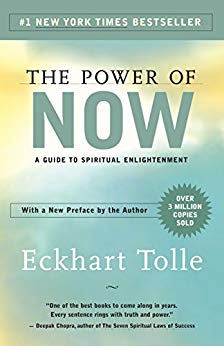

This article is an excerpt from the Shortform summary of "The Power of Now" by Eckhart Tolle. Shortform has the world's best summaries of books you should be reading.
Like this article? Sign up for a free trial here .
How often do you think about the past, future, something that isn’t helping you with the task at hand? Are you in control of your thoughts, or are they taking you on a ride?
Many of us spend unnecessary time and energy in repetitive and unproductive thoughts, fantasizing or worrying about the future or ruminating about the past. As a result, we often lose sight of what is happening in our immediate awareness. To prevent this from happening, take control of your thoughts by practicing being present in the moment.
Here is how staying present can help you assume control over your mind.
Use Your Mind; Don’t Let It Use You
Presence does not mean never using your mind, but rather using it deliberately. Your mind is a tool; use it productively for specific tasks, then put it to rest.
The mind becomes dangerous when it stops being a tool that we use, and instead has control over us. When you use our mind only for practical purposes, instead of leaving it running all day, it will be sharper and more focused when you need it.
- (Shortform note: Research reveals that overthinking depletes our limited supply of working memory, which allows us to focus on cognitively demanding tasks, as well as willpower.)
If you stay present in the Now and face a situation that needs immediate action, you will be able to act with clarity and awareness.
- In a life-or-death situation, people just act. They don’t have time to analyze the situation or panic about what a terrible problem it is. They just do what needs to be done.
- By the same token, some people find presence by pursuing life-threatening situations or adrenaline-filled activities, because they are so extreme that your whole body and mind focus on the Now.This is why some adrenaline junkies get hooked on extreme and dangerous activities.
We are most creative when we are present. Artists tend to talk about creative processes characterized by ideas flowing through them, not painstaking sessions of overanalysis.
- (Shortform example: Many famous songs — from Beyonce’s “Single Ladies” to the Beatles’ “Yesterday” — were written in a matter of minutes. In fact, studies show that the area of the brain associated with thinking is different than the area of the brain active in creative tasks, suggesting that overthinking cognitively inhibits creativity.)
The mind is good at collecting, storing, and analyzing information. True creativity and innovation come from moments of no-mind, when you are unrestricted by thoughts (e.g., “No one has ever been able to do this before.”) and judgments (e.g. “This is a terrible idea!”).
- Scientists have reported that great breakthroughs came when their thoughts were quiet.
- In 1945, French mathematician Jacques Hadamard sent an inquiry to eminent mathematicians — including Einstein — about their working methods. He concluded that thinking “plays only a subordinate part” in the creative act.
When you need to approach something with creativity and innovation, take a moment to clear your mind. Putting all your attention on breathing can help you take control of your thoughts. When you return to the task at hand, your thoughts will be fresh and creative.
- Go back and forth like this every few minutes while you are tackling a puzzle or problem.
Practice Being Present
Being aware of your inner body —your mental and emotional state and the energy it creates within you — keeps you present in the Now. As you move through your day, don’t put all your attention in the external world around you. Keep some awareness on your inner body at all times.
Follow these steps for inner body awareness.
Ask yourself, “Am I at ease in this moment?” Or, “What’s going on inside me right now?”
- Before you answer, take a moment of self reflection.
- What kinds of thoughts are you having?
- What are you feeling?
- Is there any tension in your body?
- If you notice some unease, reflect on where that is coming from. Are you anxious about a big project at work? Do you have some residual resentment from an argument you got into yesterday with your sister? Are you tired from a long day and annoyed that you have to help the kids with homework when all you want to do is relax? Most likely, you are not present and are resisting the Now in some way.
If you’re having a hard time connecting with your inner body, try these methods.
- Get away from phones, people, and other distractions.
- Sit in a chair. Don’t lean back, keep your spine straight. Relax your body.
- Put your attention on your breathing. Observe the air coming in and out. Feel your lungs as they expand with air, and then empty.
- Accept the world around you exactly as it is.
- Listen to the sounds around you. Don’t think about them, just acknowledge them. Observe the silence in between sounds.
- Look at the shape, color, and texture of everything around you. Again, just acknowledge these objects without interpreting anything about them.
- Close your eyes. Take a few deep breaths. With each breath, feel your stomach fill with air and then empty again.
- Put your attention on your inner body. Do you feel the life in your hands, arms, feet, legs, chest, stomach?
- Feel the energy that flows through your body with each breath.
- If it helps, imagine that you are surrounded by a light that fills your body with every breath. Imagine that light illuminating your entire being, vibrating with energy.
- Keep focusing on your inner body. Try to feel it without thinking about it.
- If possible, let go of the image in your mind of the light.
- Feel the presence and energy of your inner body. Let that feeling transcend the boundary of inner and outer body, and just envelope your entire being.
- Stay in this state of presence as long as you feel comfortable. When you’re ready, slowly become aware of your physical body again. Gently open your eyes and look around with a soft gaze. For a few minutes, just take in your surroundings, remaining aware of your inner body.
The more often you can connect with your inner body, the more presence you are able to maintain. Once you are present, you will not stay there — you will need to remind yourself and practice, and eventually you will spend more time in the Now. When you can do this consistently you have reached enlightenment. More on enlightenment later.
———End of Preview———

Like what you just read? Read the rest of the world's best summary of "The Power of Now" at Shortform . Learn the book's critical concepts in 20 minutes or less .
Here's what you'll find in our full The Power of Now summary :
- Why you feel pain from the past, and how to get rid of it
- How to be more present and stop worrying about the future
- The 8 key ways to achieve mindfulness






